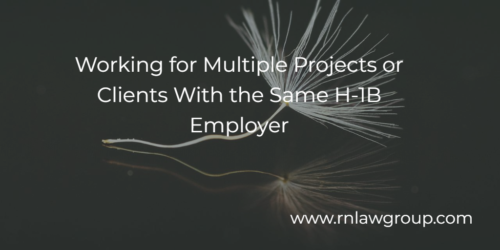
Working for Multiple Projects or Clients With the Same H-1B Employer
With the COVID-19 pandemic came the rise of working remotely. With this, came the opportunity for employees to work additional assignments for their employers as they no longer had to be physical onsite and can work remotely. For H-1B workers who have skills that are highly in demand, this has given them the opportunity, should they want it, to take on additional work to receive additional compensation. Of course, it is not abnormal for a company to compensate an employee more for additional work, but how can the H-1B worker and the company structure this to not cause immigration issues?
As a preliminary matter, it is important to note that this article will only address taking on additional work with the same H-1B employer. For example, if you are set to work pursuant to your LCA at ABC client and your company wants you to take on additional work for XYZ client. This articles does not apply to working pursuant to Company A and Company B. Notably, the major concern for both the employer and the employee is violation of the labor condition application (LCA) salary. For instance, if the employee is set to be paid $95,000 but is going to take on an additional side project for the same employer, the question becomes, how can the company structure the additional payment without possibly causing LCA issues?
The possible solution is to treat the additional work, as most employers would, and run additional compensation as a bonus. First and foremost, the company should have a policy on how it compensates all employees for additional work performed, how the compensation is paid out, when it is paid out, etc. This policy should be applicable to all employees in similar positions regardless of immigration status, and should be put in the employment handbook or generally available. From a practical standpoint, the bonus should be run through the payroll as a separate line item separate from the salary. This will help prevent confusion as to the actual salary and bonus. Further, the company should document the reason for the bonuses and keep records of it.
While USCIS has had situations in the past of questioning overpayment to H-1B workers, and likely wrongly so, being able to document that there was additional work performed and bonus compensation that is separate from the general salary should be sufficient to show that everything is in line with the requirements of the H-1B program.
By: Steven Brown
Steven Brown is a Partner at Reddy Neumann Brown PC where he works in the Non-immigrant visa department and leads the Litigation Team. His practice covers all phases of the non-immigration visa process including filing H-1B, L-1, E-3, H-4, and H-4 EAD petitions. In the last two years, Steven has successfully handled over 1,000 non-immigrant visa petitions including filing petitions, responding to any necessary Requests for Evidence, and drafting motions and appeals. He has also become a key resource for F-1 students that seek guidance on properly complying with the F-1 visa regulations and any OPT or CPT issues they may have. Additionally, Steven holds a weekly conference call for companies that are part of one of the largest organizations for IT Services companies in America.
Reddy & Neumann has been serving the business community for over 20 years and is Houston’s largest immigration law firm focused solely on US. Employment-based immigration. We work with both employers and their employees, helping them navigate the immigration process quickly and cost-effectively

